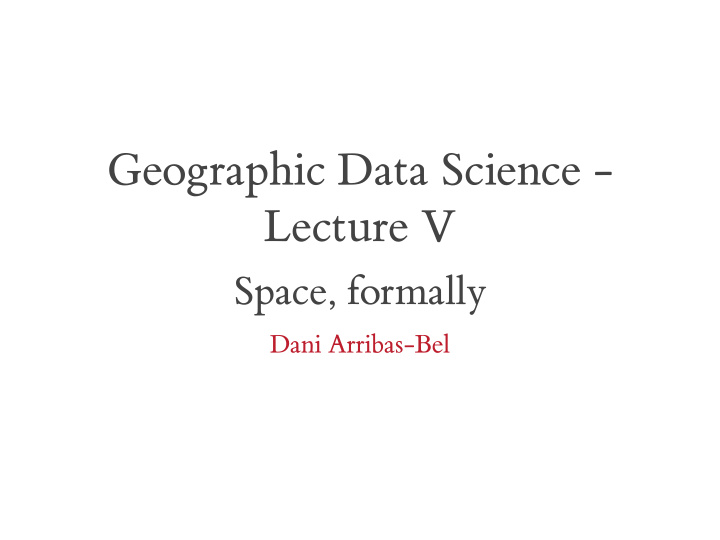



Geographic Data Science - Lecture V Space, formally Dani Arribas-Bel
Today The need to represent space formally Spatial weights matrices What Why Types The spatial lag The Moran Plot
Space, formally
For a statistical method to be explicitly spatial , it needs to contain some representation of the geography, or spatial context One of the most common ways is through Spatial Weights Matrices
(Geo)Visualization : translating numbers into a (visual) language that the human brain “speaks better” Spatial Weights Matrices : translating geography into a (numerical) language that a computer “speaks better” .
Core element in several spatial analysis techniques: Spatial autocorrelation Spatial clustering / geodemographics Spatial regression
W as a formal representation of space
W N x N positive matrix that contains spatial relations spatial relations between all the observations in the sample x > 0 if i and j are neighbors w ij = { } 0 otherwise wii = 0 by convention …What is a neighbor neighbor???
Types of W A neighbor is “somebody” who is: Next door → Contiguity -based W s Close → Distance -based W s In the same “place” as us → Block weights … See Anselin & Rey (2014) for an in-detail discussion and more types of W .
Contiguity-based weights Sharing boundaries to any extent Rook Queen …
Distance-based weights Weight is (inversely) proportional to distance between observations Inverse distance (threshold) KNN (fixed number of neighbors) …
Block weights Weights are assigned based on discretionary rules loosely related to geography For example: LSOAs into MSOAs Post-codes within city boundaries Counties within states …
How much of a neighbor? No neighbors receive zero weight: wij = 0 Neighbors, it depends, wij can be: One wij = 1 → Binary Some proportion (0 < wij < 1, continuous) which can be a function of: Distance Strength of interaction (e.g. commuting flows, trade, etc.) …
Choice of W Should be based on and reflect the underlying channels of interaction for the question at hand. Examples: Processes propagated by inmediate contact (e.g. disease contagion) → Contiguity weights Accessibility → Distance weights Effects of county differences in laws → Block weights
Do your own (contiguity) weights time!
Standardization In some applications (e.g. spatial autocorrelation) it is common to standardize W The most widely used standardization is row-based : divide every element by the sum of the row: w ij ¯ w ij = w i ⋅ where wi · is the sum of a row.
The spatial lag
The spatial lag Product of a spatial weights matrix W and a given variably Y Ysl = WY ysl − i = ∑ jwijyj
Measure that captures the behaviour of a variable in the neighborhood of a given observation i . If W is standardized , the spatial lag is the average value of the variable in the neighborhood
Common way to introduce space formally in a statistical framework Heavily used in both ESDA and spatial regression to delineate neighborhoods. Examples: Moran’s I LISAs Spatial models (lag, error…)
Recapitulation Spatial Weights matrices: matrix encapsulation of space Different types for different cases Useful in many contexts, like the spatial lag and Moran plot, but also many other things!
<a rel="license" href="http://creativecommons.org/licenses
Recommend
More recommend